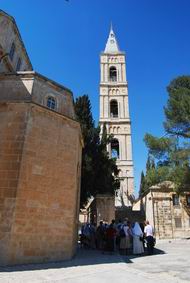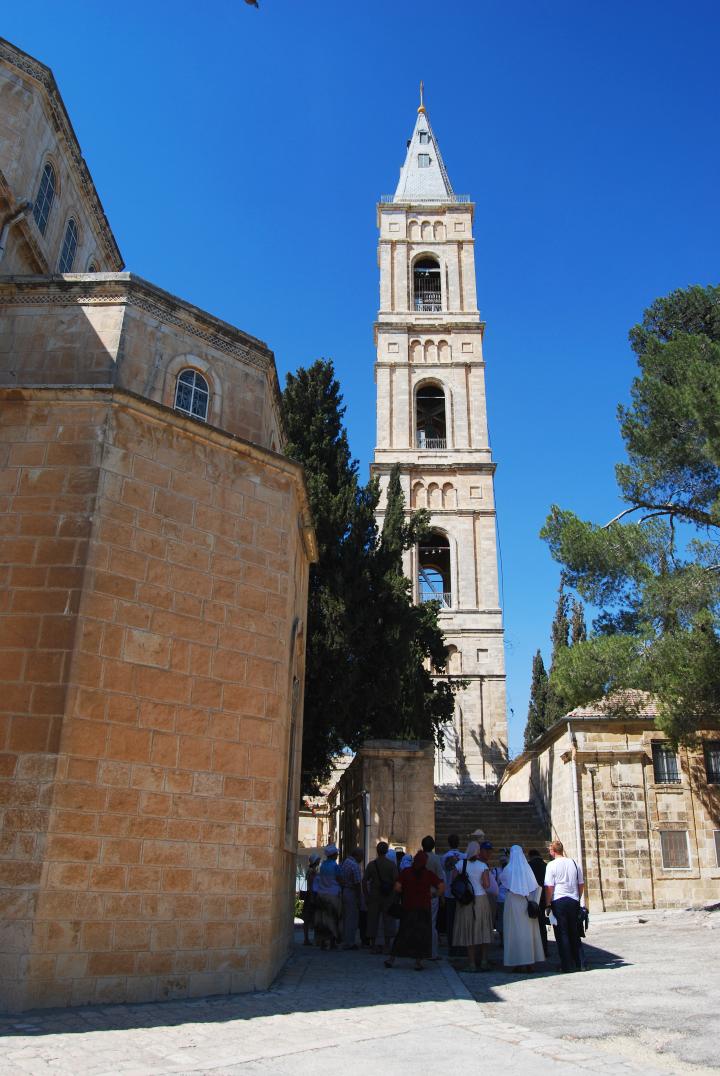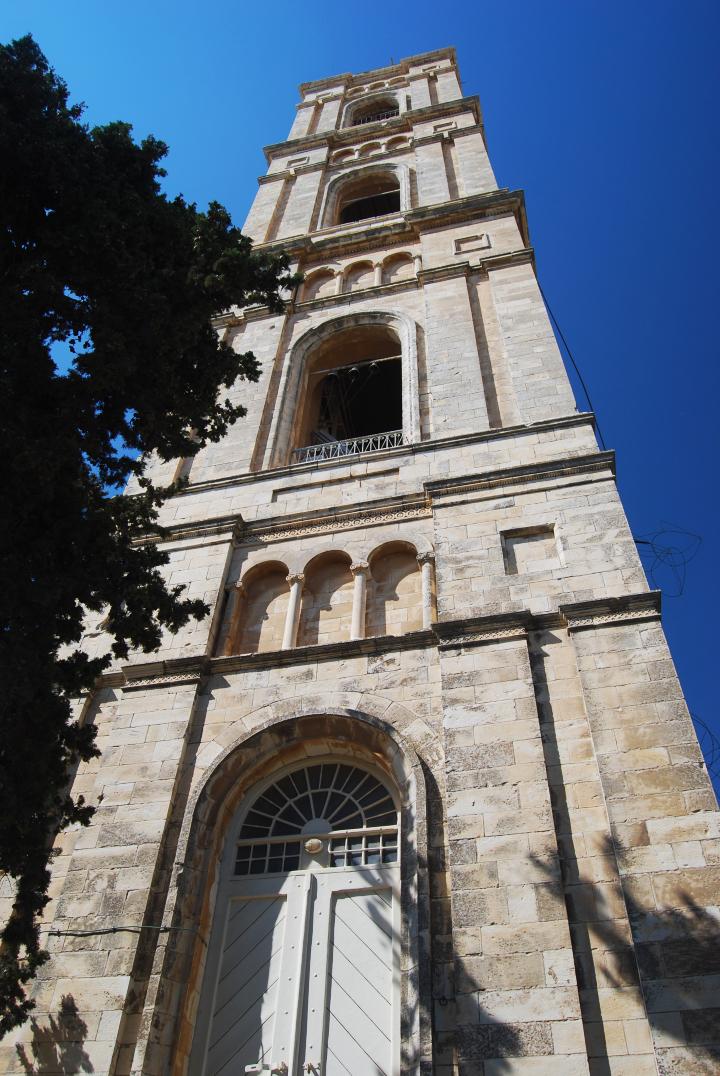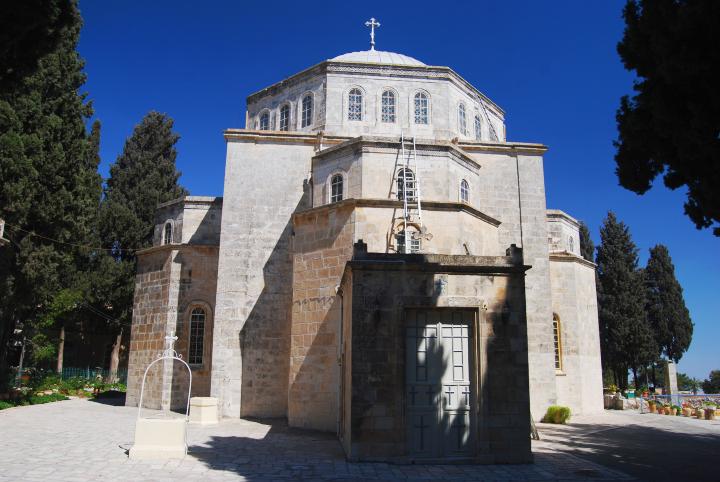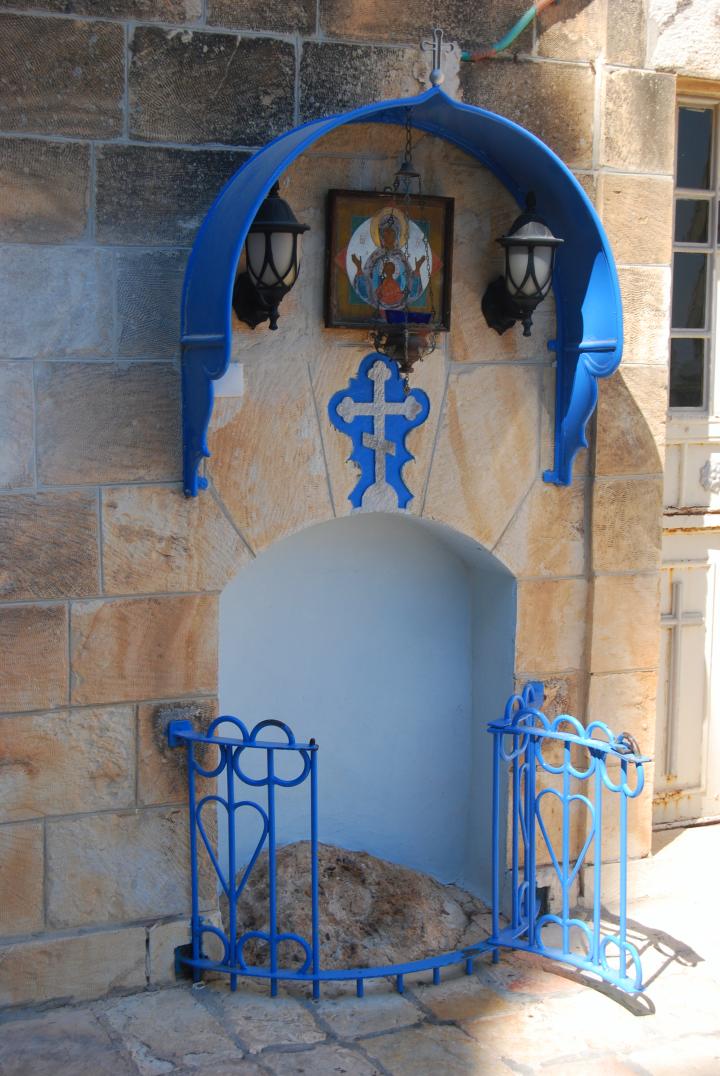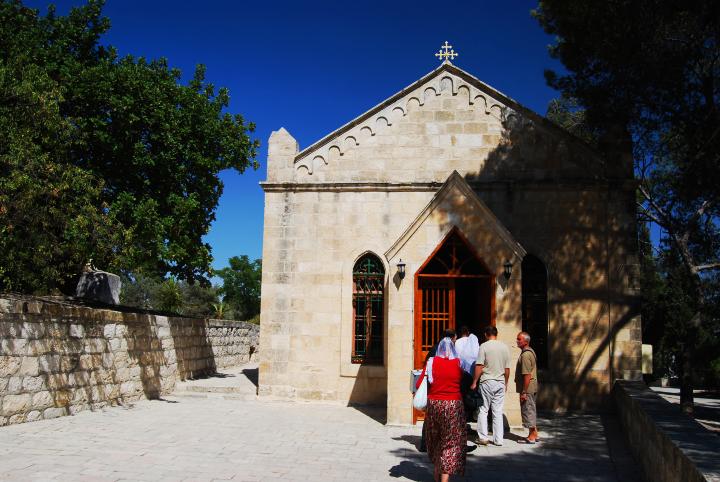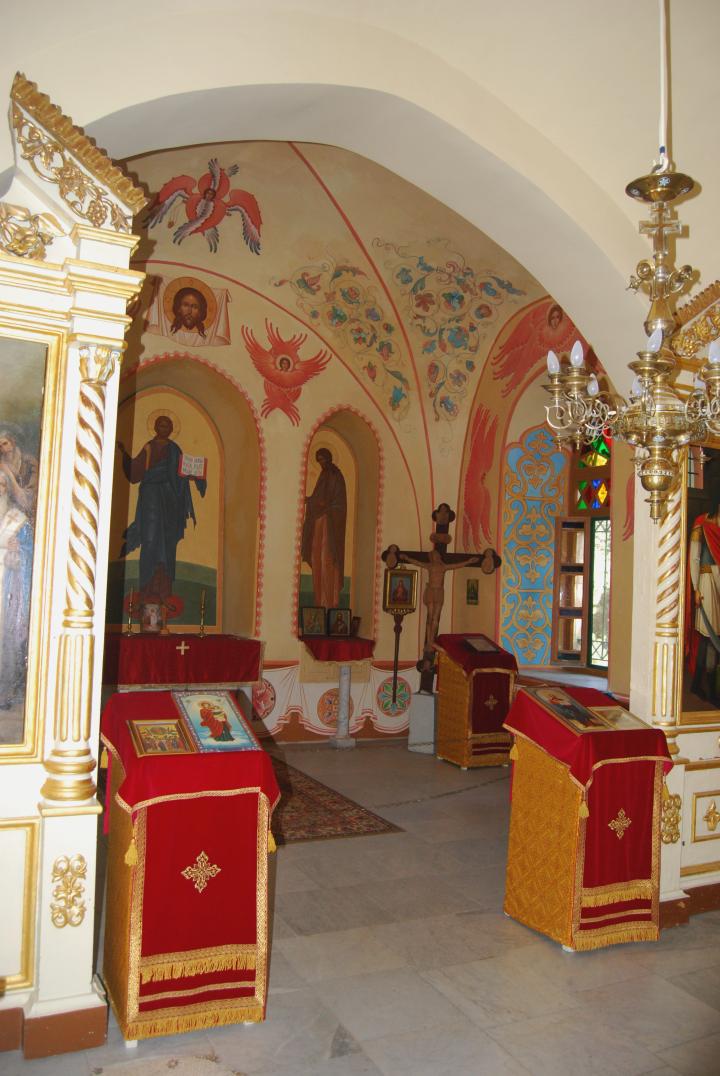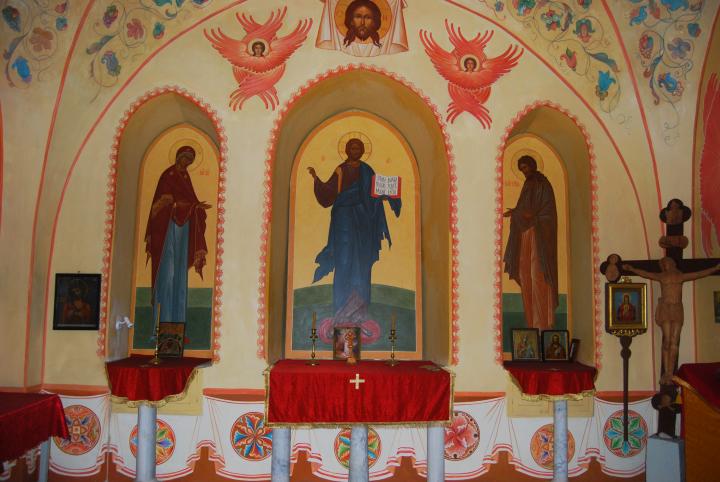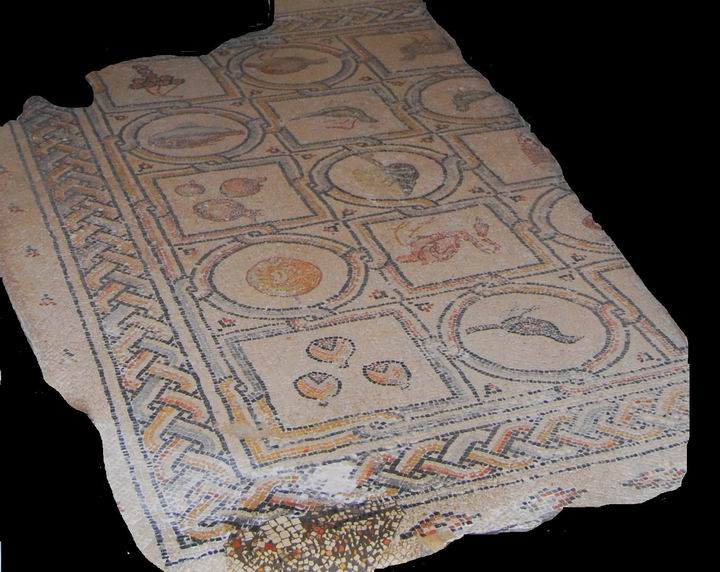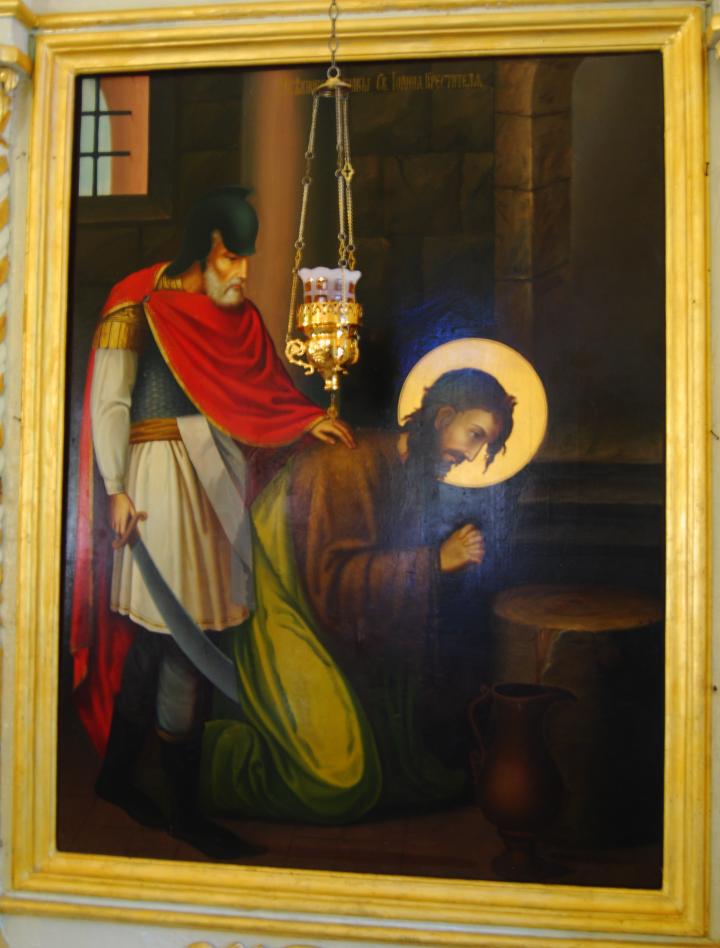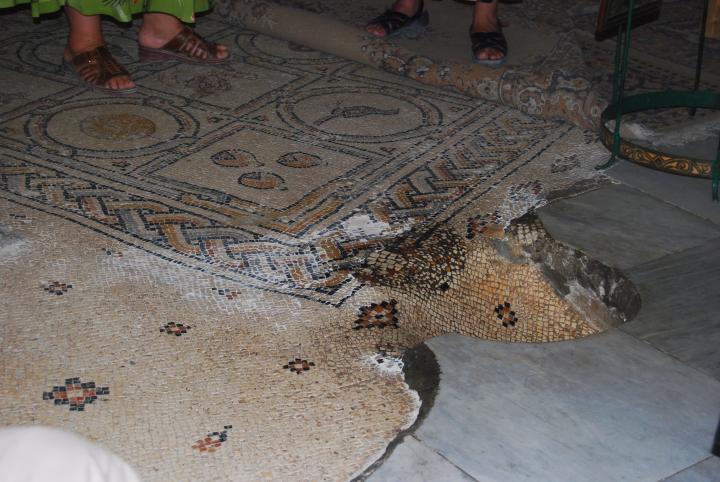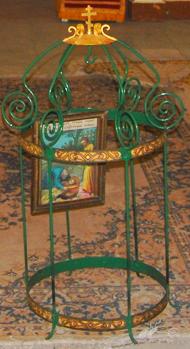According to the Russian Orthodox tradition, this sacred site is where Jesus ascended to heaven 40 days after resurrection. Another tradition marks the site where the head of John the Baptist was found.
Home > Sites > Jerusalem > Mt. Olives > Russian Orthodox Convent of the Ascension
Contents:
Overview
Location
History
Photos
* Bell Tower
* Church
* Armenian Chapel
* John the Baptist
Biblical
Historical
Etymology
Links
Overview:
The Russian Orthodox Convent of the Ascension is a religious site located in the village of A-Tur on the Mount of Olives in Jerusalem. According to Orthodox tradition is the site where Jesus ascended to heaven 40 days after resurrection. Acts 1:9: “And when he had spoken these things, while they beheld, he was taken up.”
It was founded in the late 19th century by Grand Duchess Elizabeth Feodorovna of Russia, who was a member of the Russian royal family and had become a nun after her husband’s assassination.
The convent’s main church is dedicated to the Ascension of Jesus Christ and is decorated with beautiful frescoes and icons. It also contains relics of Saint Elizabeth and other saints. The convent includes several other buildings, including a hospital, a school, and a guesthouse for pilgrims. It has a peaceful garden with views of the Old City of Jerusalem and the Dome of the Rock.
A chapel behind the church is dedicated to John the Baptist, and according to tradition his head was found in a jar hidden in a cavity under the mosaic floor of an ancient Armenian church.
Location:
The Russian Orthodox Church of the Ascension is located near a tall tower inside the village of A-Tur.
An aerial view is seen below showing the location of the church (marked by “Russian Ascension” near A-Tur) and other points of interest (such as the Ascension chapel, another traditional site).

History of the place:
-
Herod
The site was built over structures from 1st century BC (Herodian).
-
New Testament
According to Russian Orthodox tradition, this is the site where Jesus ascended to heaven 40 days after resurrection (Luke 24 51: “And it came to pass, while he blessed them, he was parted from them, and carried up into heaven”).
Another tradition is that the head of John the Baptist, beheaded by Herod Antipas, was found in the 4th century in a jar hidden in the chapel adjacent to the church. John is an important figure in Christianity , and regarded as the “forerunner” – since John Baptized Jesus, and proclaimed Jesus as the Messiah.
-
Byzantine period
On the site of the convent were two 5th century Armenian churches. One of these churches was named after John the Baptist. Their mosaic floors were uncovered during the construction of the convent, and one of the mosaic floors was embedded in the chapel behind the church.
-
Ottoman period
The Russian Orthodox convent and church was built in 1870-1887. It was one of the Holy Land projects that were originated by Archimandrite Antonin Kapustin, as part of the Russians to expand their presence in the land and the Holy city.
A 64 M high bell tower was designed to symbolize the ascension to heaven. It added a remarkable landmark in the Jerusalem’s skyline, as seen here. It was the first Christian bell to operate in Jerusalem.
The bell tower dominates the top of Mt Olives, seen here from the old city
The founder, Antonin Kapustin, died in 1894 and is buried in the left side of the entrance to the church.
The community was assembled by Father Parthenius, which was officially acknowledged in 1906. He was found stabbed to death in 1909 and is also buried behind the church.
During World War I, the convent was seized by Ottoman forces and Grand Duchess Elizabeth was martyred along with other members of the Russian royal family. The convent was later returned to the Russian Orthodox Church and has since become an important pilgrimage site for Orthodox Christians from around the world.
-
Modern times
The convent is open to the public on limited hours or for organized groups. The place is inhabited by Nuns.
Photos:
(a) Bell Tower:
The impressive 64M bell tower was built during the construction of the convent (1870-1887). It was the first Christian bell to operate in the Ottoman city. It dominates the area of the convent and the skyline of old Jerusalem.
Click on the photos to view in higher resolution…
Another view of the impressive bell tower.
(b) Church:
The church of the convent is located in the center of the court yard. It is built in a Neo-Byzantine style, and its design is a cape that is supported by a hexagon structure.
Behind the church, on its right side, is a rock behind a blue fence. This rock is according to tradition the place where Virgin Mary stood when Jesus ascended to heaven.
The blue cross above the rock is the symbol of the Russian church. The lower bar is tilted, and symbolizes the two robbers that were crucified with Jesus (the top left side is the “good” robber). Another interpretation is that the lower bar is the footrest, and usually another small bar appears in the top side of the cross symbolizing the inscription over Jesus head.
(c) Chapel of St John the Baptist:
To the north of the Church, behind a small cemetery, is a chapel dedicated to John the Baptist. It is built over the ruins of a 6th C Armenian church, and parts of the ancient church mosaics are seen near the entrance.
The interior of the chapel is seen below. The small cage on the floor marks the site where the head of John the Baptist was found. Under the rug is a section of a magnificent 6th century mosaic floor.
A view of the altar is seen below.
A closer view of the altar – with Mary on the left side, Jesus in the center, and John on the right.
On the floor of the chapel is a section of a 6th C Byzantine mosaic, which was a part of the ancient Armenian church dedicated to John the Baptist. During ceremonies the rug that covers the floor is unfold and reveals the mosaic floor. The mosaic depicts Holy Land fruits, birds and animals. An Armenian inscription dedicates it to bishop Jacob who built it.
(d) The head of John the Baptist:
One of the paintings in the chapel illustrates the event when the executioner of Herod Antipas beheaded John in his prison (Mark 6: 27: “…he went and beheaded him in the prison, And brought his head in a charger…”). According to the local tradition, his head was found in a jar during the 4th C Constantine period and buried in this site.
Embedded in this mosaic floor is a deep cavity, seen in the photo below. The hole is sacred, since according to the tradition it was the place where the head of John the Baptist was found in a jar, hidden by one of his followers in the 1st century, and rediscovered in the 5th century.
Visitors come here to cherish the spot, read and chant passages from texts and sermons, kneel and kiss the spot.
The head was secretly buried here according to tradition by the followers of John the Baptist during the 1st century, and was rediscovered in the 5th century.
A metal cage marks the site of the hidden head, and is placed over the rug. Inside the cage is a painting illustrating the event of the finding of the buried head. This happened in 452 AD when two monks found the site after St John appeared to them in a dream, and directed them to the cavity.
The cage is crowned by a golden Russian Orthodox cross.
Biblical:
(a) Luke 24, 50-51
According to Luke, Jesus ascended to heaven near Bethany, which is identified as a village on Mount of Olives.
“And he led them out as far as to Bethany, and he lifted up his hands, and blessed them. And it came to pass, while he blessed them, he was parted from them, and carried up into heaven”.
(b) Acts 1, 9-12
This passage identifies the Mt of Olives as the site of ascension:
“And when he had spoken these things, while they beheld, he was taken up; and a cloud received him out of their sight. And while they looked stedfastly toward heaven as he went up, behold, two men stood by them in white apparel; Which also said, Ye men of Galilee, why stand ye gazing up into heaven? this same Jesus, which is taken up from you into heaven, shall so come in like manner as ye have seen him go into heaven. Then returned they unto Jerusalem from the mount called Olivet, which is from Jerusalem a sabbath day’s journey”.
(c) Mark 6, 17-29
This text tells how Herod Antipas killed John the Baptist.
“For Herod himself had sent forth and laid hold upon John, and bound him in prison for Herodias’ sake, his brother Philip’s wife: for he had married her. For John had said unto Herod, It is not lawful for thee to have thy brother’s wife. Therefore Herodias had a quarrel against him, and would have killed him; but she could not: For Herod feared John, knowing that he was a just man and an holy, and observed him; and when he heard him, he did many things, and heard him gladly. And when a convenient day was come, that Herod on his birthday made a supper to his lords, high captains, and chief estates of Galilee; And when the daughter of the said Herodias came in, and danced, and pleased Herod and them that sat with him, the king said unto the damsel, Ask of me whatsoever thou wilt, and I will give it thee. And he sware unto her, Whatsoever thou shalt ask of me, I will give it thee, unto the half of my kingdom. And she went forth, and said unto her mother, What shall I ask? And she said, The head of John the Baptist. And she came in straightway with haste unto the king, and asked, saying, I will that thou give me by and by in a charger the head of John the Baptist. And the king was exceeding sorry; yet for his oath’s sake, and for their sakes which sat with him, he would not reject her. And immediately the king sent an executioner, and commanded his head to be brought: and he went and beheaded him in the prison, And brought his head in a charger, and gave it to the damsel: and the damsel gave it to her mother. And when his disciples heard of it, they came and took up his corpse, and laid it in a tomb”.
Historical References:
(a) Josephus: Ant. of the Jews, XVIII, 5 2:
Herod executed John the Baptist in the castle of Macherus, east of Jordan:
“Now some of the Jews thought that the destruction of Herod’s army came from God, and that very justly, as a punishment of what he did against John, that was called the Baptist: for Herod slew him, who was a good man, and commanded the Jews to exercise virtue, both as to righteousness towards one another, and piety towards God, and so to come to baptism; for that the washing [with water] would be acceptable to him, if they made use of it, not in order to the putting away [or the remission] of some sins [only], but for the purification of the body; supposing still that the soul was thoroughly purified beforehand by righteousness. Now when [many] others came in crowds about him, for they were very greatly moved [or pleased] by hearing his words, Herod, who feared lest the great influence John had over the people might put it into his power and inclination to raise a rebellion, (for they seemed ready to do any thing he should advise,) thought it best, by putting him to death, to prevent any mischief he might cause, and not bring himself into difficulties, by sparing a man who might make him repent of it when it would be too late. Accordingly he was sent a prisoner, out of Herod’s suspicious temper, to Macherus, the castle I before mentioned, and was there put to death. Now the Jews had an opinion that the destruction of this army was sent as a punishment upon Herod, and a mark of God’s displeasure to him”.
(b) Laurence Oliphant “Haifa”
Laurence Oliphant “Haifa, or Life in Modern Palestine” [1887]
His article was published on Aug 10 1885 in the New York “Sun”, with the title “Progress and Development in Jerusalem”, where he tells his readers about the new events in the Holy city, over 120 years ago. He reports that he witnessed the hauling of the 8-Ton bell from Jaffa to Mt Olives, and the celebrations of the new bell tower. After then Laurence visits the chapel, ancient tombs and mosaics in the convent’s yard.
His reports include unique descriptions of the reviving city, and the excitement of the rediscovery of the Holy Land after hundreds of years of stagnation.
Etymology (behind the name):
A-Tur (At-Tur, Et-Tur) – Arabic: “The Mount” (of Olives) – an Arab neighborhood on top of Mt of Olives where the Ascension church is located.
Also called Tur-Malka (The mount of the queen), based on the Hebrew word Malka = “Queen”.
John – the Baptist. from Hebrew, “Yochanan”, which means: Yo (God) + Chanan (Pardoned). Thus the name John in Hebrew means “God has pardoned”.
Biblical Reference: Mark 1 4,5: “John did baptize in the wilderness…in the river of Jordan”.
Links:
The Ascension: points of interest on Mount Olives:
- Augusta Victoria – “Evangelical Lutheran Church of the Ascension”
- Chapel of Ascension – another traditional site, located nearby
John the Baptist: other sites in Jerusalem:
- St John the Baptist church in old city
Archaeological:
- Jerusalem municipal survey (Hebrew)
BibleWalks.com – making the Bible
Ascension chapel<—previous site–<<< All Sites >>>—next Jerusalem site–> Pater Noster
This page was last updated on Mar 19, 2023 (new overview)
Sponsored links:
